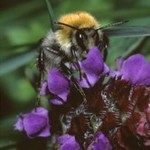 European researchers have recently provided, for the first time, evidence of a significant decline in wild bee diversity in the United Kingdom and the Netherlands over the past 25 years. The scientists also observed that the loss of this pollinator’s diversity is consistent with the loss of bee-pollinated plants.
European researchers have recently provided, for the first time, evidence of a significant decline in wild bee diversity in the United Kingdom and the Netherlands over the past 25 years. The scientists also observed that the loss of this pollinator’s diversity is consistent with the loss of bee-pollinated plants. As many crops are directly dependant on insects for their pollination, the reported decline in the bee population may have severe implications for
During recent decades, human impact on habitats and climate has resulted in important changes in many populations of animal and plant species around the world. In particular, previous studies have suggested that specific pollinating insects are experiencing a significant decline, but to date, little evidence has been found to suggest a large scale problem. The loss of pollinating insects, such as bees and hoverflies, is of concern because of their potential effects on many agricultural crops and other natural plants dependant on insect pollination.
A recent study carried out under the EU-funded research project ALARM1 has reported for the first time a significant large-scale decline in pollinator diversity across the United Kingdom and the Netherlands since 1980.
The researchers found that wild bee diversity has fallen in almost 80% of the studied sites over the past 25 years. Changes in hoverfly diversity were found to be less consistent.
The scientists also examined possible shifts in the distribution of plant species using floral inventories to determine whether there was a link between changes in pollinators and the plants dependant on insects for their pollination. The results suggest that there is a causal relationship between the decline in pollinators and that in plants, although the ultimate causes for the decline are not clear.
The reported loss of wild bee populations could have important implications for farming as many European crops, including fruits and vegetables, as well as nuts, seeds and herbs, are directly dependant on insects for their pollination.
According to the authors, similar shifts to those reported in these two countries can be expected in other parts of north-western Europe. The authors recommend further documenting the geographical extend of the decline and investigating the possible causes, considering habitat alteration, climate change and agricultural climate usage as the potential key drivers.



